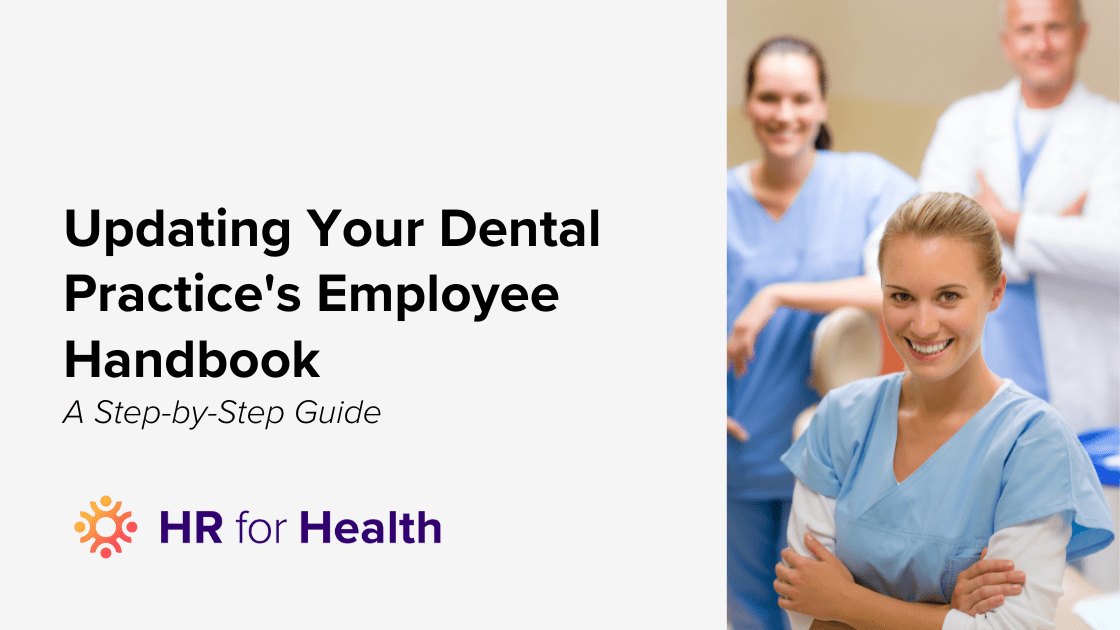- Dental
- Employee Handbook
A Step-by-Step Guide to Updating Your Dental Practice’s Employee Handbook

Updating your dental practice’s employee handbook ensures that your policies align with current laws and your practice’s operational needs. An updated handbook not only helps maintain legal compliance but also serves as a valuable resource for your team, guiding them on policies, benefits, and workplace behavior. HR for Health specializes in helping dental practices maintain the highest standard of professional resources. Our guide provides a structured approach to updating your employee handbook efficiently and effectively.
Learn more about the importance of updating your employee handbook regularly. Then, contact us today to learn more about how we can help you.
The Importance of the Employee Handbook
An employee handbook is the cornerstone of clear communication between a dental practice and its staff. It sets forth the expectations for employees and provides a point of reference for them to understand their rights and responsibilities within the practice. By clearly outlining company policies, the handbook ensures consistency and fairness in handling workplace matters, which can help prevent misunderstandings and disputes.
Furthermore, a well-structured employee handbook can also serve as a protection for the practice. It offers legal safeguards by demonstrating that employees know workplace rules and procedures. This is particularly valuable in defending against possible employment disputes. Regular updates to the handbook reflect ongoing commitment to compliance and employee welfare, reinforcing a positive workplace culture.
Why You Might Need To Update Your Employee Handbook
There are several reasons why you might need to update your employee handbook. They include:
- Changes in Employment Laws: Laws related to employment and labor are frequently updated. Your handbook must reflect these changes to ensure compliance and protect the practice and its employees.
- Shifts in Workplace Culture: As your dental practice evolves, so too might your workplace culture. Updating your handbook can help address these changes and clarify the expectations and norms that come with them.
- Introduction of New Technology: With new technology being implemented in dental practices, it’s essential to update policies on its use, including data privacy and security measures.
- Feedback from Employees: Employee feedback can illuminate areas of the handbook that may be unclear or insufficient. This feedback is valuable for making the handbook more relevant and easily understood.
- Legal Protections: Regular updates to the handbook can close loopholes and strengthen legal defenses should employment issues arise. Ensuring that all guidelines and policies are up to date with current legal standards is crucial for protecting the practice.
If any of these issues impact your practice, you might need to update your employee handbook. To ensure that your updates are comprehensive, you should follow several steps.
1. Assess Your Current Handbook
Begin by thoroughly reviewing your existing employee handbook. Evaluate each section to determine its relevance and accuracy against current operations and legal requirements. This review will help identify any content that may be outdated or missing. It might have been a long time since you last updated your employee handbook, so there could be a number of changes.
After this, gather input from various stakeholders within your practice, including management, HR, and other key staff members. Their insights can provide practical perspectives on what changes are necessary. This collaborative review ensures that the handbook meets legal standards and aligns with your practice’s day-to-day realities.
2. Find Key Areas to Update in Your Handbook
After assessing the current content, you’ll need to identify specific areas that require updates to meet the evolving needs of your practice and changes in employment law. There are a few specific areas that deserve extra attention.
Employment Policies
Updating employment policies is critical for compliance and clarity. Review policies on anti-discrimination, harassment, workplace safety, and employee benefits. Ensure they reflect current laws and best practices, and clearly communicate your practice’s expectations and legal obligations. There is a chance that your policies might have changed since the last time you updated the handbook.
Office Culture and Conduct Guidelines
Your handbook should reflect the culture you want to cultivate within your practice. Update sections that outline expected behaviors, dress code, and ethics to ensure they foster the professional and welcoming environment you aim for. Clearly defined conduct guidelines help maintain a positive workplace atmosphere and reduce the likelihood of misconduct.
3. Identify and Incorporate New Employment Laws
Stay informed about changes in employment laws that impact your practice. This might include updates to federal, state, or local regulations regarding wages, leaves of absence, and benefits. Accurate legal compliance is crucial not only for legal protection but also for employee trust and retention.
Incorporating these new laws into your handbook can sometimes require significant changes to policy language and structure. It’s smart to work with legal professionals who specialize in employment law to ensure that your handbook meets all legal requirements. It would be our pleasure to see if any recent employment law updates might impact the way you write your employee handbook.
4. Revise the Compensation and Benefits Sections
Ensure that your handbook accurately reflects the current compensation packages and benefits offered to your employees. This section should include any changes in pay structures, bonus schemes, health benefits, retirement plans, and other perks that your practice offers.
Furthermore, clearly outline the eligibility criteria for these benefits and any changes to them. Transparent communication about compensation and benefits helps manage employee expectations and enhances job satisfaction.
5. Update Safety and Emergency Procedures
Safety procedures are particularly critical in a dental practice setting. Update your handbook to include comprehensive guidelines on handling medical emergencies, equipment safety, and workplace hazards. Ensure all procedures comply with OSHA regulations and best practices in dental health safety.
Include a clear action plan for emergencies that covers both patient and employee safety concerns. Regular training on these procedures should also be documented within the handbook to ensure that all team members are prepared to respond appropriately.
6. Address Technology Use and Data Privacy Policies
With the increasing use of digital tools in dental practices, it’s important to have clear policies on technology use. Address expectations for using practice management software, patient data privacy, and security protocols. Clearly outline acceptable use of internet and social media during work hours.
In addition, ensure that your handbook includes policies on data breaches and the protocol for reporting and responding to such incidents. This not only protects patient information but also helps maintain the integrity and reputation of your practice.
7. Update the Misconduct and Grievance Procedures
Clearly outline the procedures for reporting and handling misconduct within your practice. Ensure these processes are fair, transparent, and comply with legal standards. This section should provide a clear pathway for employees to report grievances and for management to respond effectively.
Furthermore, updating these procedures can help reinforce a culture of accountability and respect within the practice. It assures employees that their concerns are taken seriously and handled professionally.
The Importance of Seeking Professional Legal Advice in Handbook Revision
Consulting with a professional legal advisor is essential when updating your employee handbook. Legal experts can provide insights into recent legislative changes and help you navigate complex employment laws. Their guidance ensures that your handbook is compliant and effective in mitigating potential legal issues.
Furthermore, a legal perspective can help you understand the implications of each policy change, ensuring that your handbook serves as a robust guide for legal and operational practices within your dental office. Do not hesitate to reach out to us with any questions or concerns.
8. How To Implement the Updated Handbook
Once revisions are complete, implementing the updated handbook effectively is crucial for ensuring that all employees understand and adhere to the new policies. Distribute the updated handbook to all staff members and hold a meeting to discuss significant changes.
Encourage questions and feedback to ensure clarity and buy-in from your team. It’s also beneficial to require employees to sign an acknowledgment form stating they have received, read, and understood the new handbook. This can help safeguard your practice against potential disputes or misunderstandings.
9. Schedule Regular Reviews of the Handbook
Scheduling regular reviews of your employee handbook is necessary to keep it relevant and effective. Plan to review the handbook annually or whenever significant regulatory or operational changes occur. Regular updates will help you maintain compliance with evolving laws and ensure that your policies reflect the current state of your practice.
Next, consistent updates demonstrate to your employees that you are committed to maintaining a fair and professional workplace. This can enhance employee morale and reduce turnover.
Contact HR for Health for Help Updating Your Employee Handbook
Updating your dental practice’s employee handbook is a critical task that requires careful attention to detail and an understanding of current employment laws. HR for Health is here to assist you with every aspect of this process. From legal compliance to policy development and employee engagement, we ensure your handbook is an effective foundation for your practice’s policies and procedures.Reach out to us today to get started on updating your employee handbook. Let us help you protect your practice while creating a positive and compliant workplace for your team.
FAQs: Updating Your Dental Practice’s Employee Handbook
Q1: Why is it important to update my dental practice’s employee handbook?
A1: Regular updates keep your handbook compliant with current laws, reflect your evolving workplace culture, and ensure clear communication of policies to staff.
Q2: What areas should I focus on when updating the handbook?
A2: Key areas include employment policies, safety procedures, compensation and benefits, and technology use guidelines.
Q3: What role do legal professionals play in the update process?
A3: Consulting with legal experts ensures your handbook complies with employment laws, helping to mitigate potential legal issues.
Q4: How does HR for Health assist in updating the handbook?
A4: HR for Health provides expertise in legal compliance, policy development, and employee engagement, ensuring your handbook supports your practice effectively.
Tags

